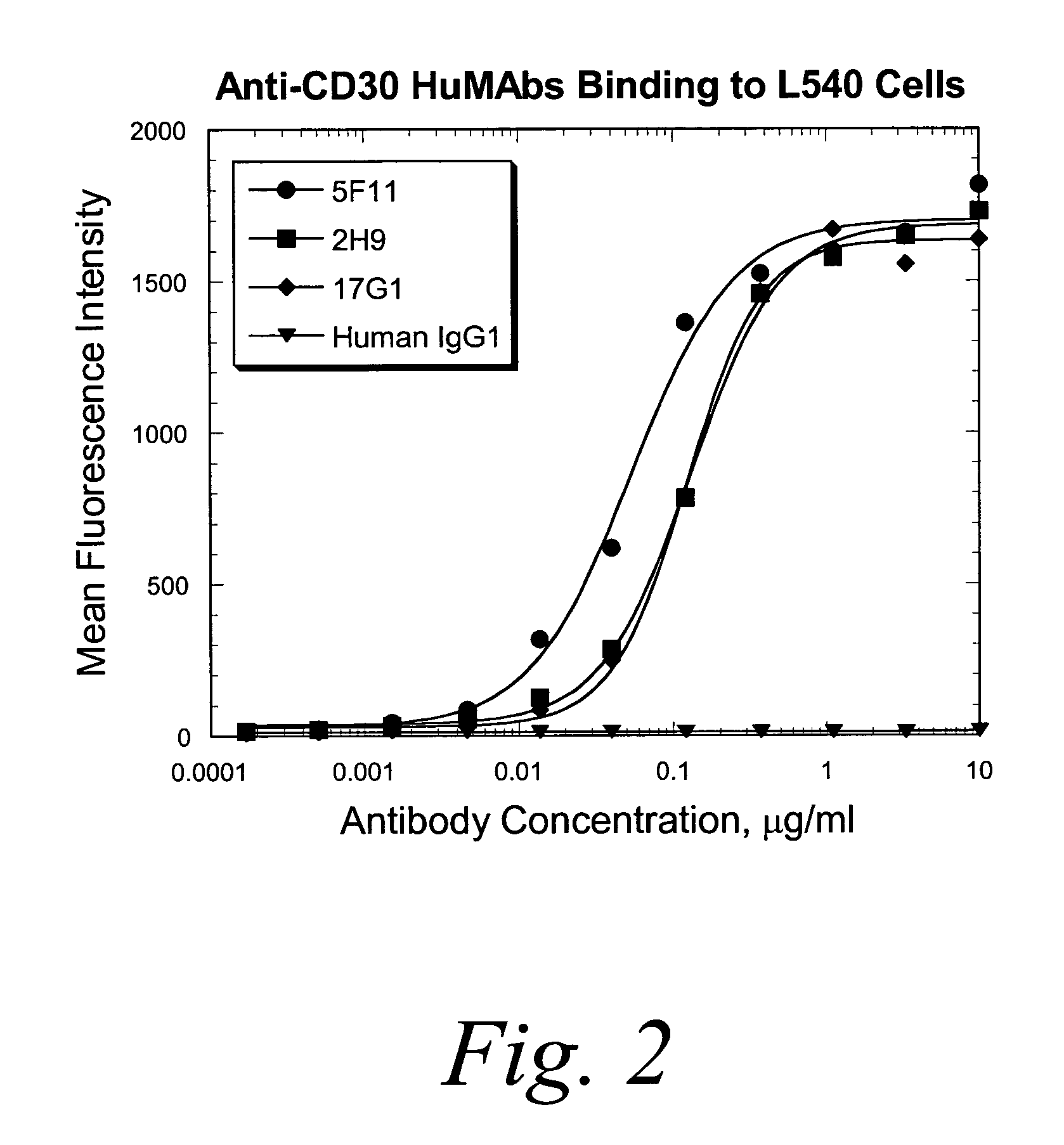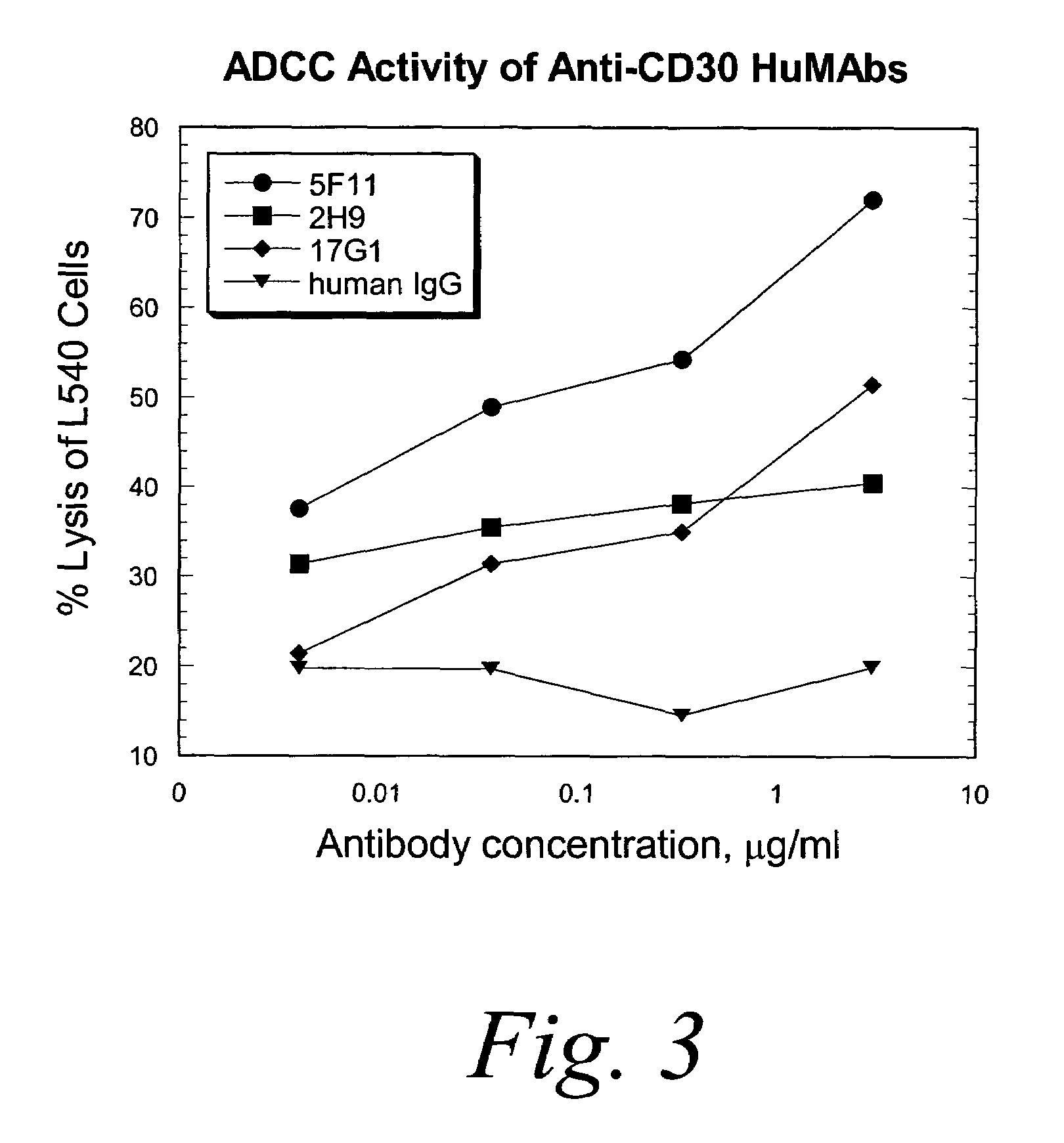Human monoclonal antibodies against CD30
a technology cd30, which is applied in the field of human monoclonal antibodies against cd30, can solve the problems that current murine antibodies do not constitute ideal therapeutic agents, and achieve the effect of increasing the therapeutic efficacy of human anti-cd30 antibodies
- Summary
- Abstract
- Description
- Claims
- Application Information
AI Technical Summary
Benefits of technology
Problems solved by technology
Method used
Image
Examples
example 1
Generation of CD30-Specific Human Monoclonal Antibodies (HuMabs)
I. Generation of Transgenic (Cmu Targeted) Mice for the Production of Fully Human Monoclonal Antibodies to CD30
Construction of a CMD Targeting Vector
[0259]The plasmid pICEmu contains an EcoRI / XhoI fragment of the murine Ig heavy chain locus, spanning the mu gene, that was obtained from a Balb / C genomic lambda phage library (Marcu et al. Cell 22: 187, 1980). This genomic fragment was subcloned into the XhoI / EcoRI sites of the plasmid pICEMI9H (Marsh et al; Gene 32, 481-485, 1984). The heavy chain sequences included in pICEmu extend downstream of the EcoRI site located just 3′ of the mu intronic enhancer, to the XhoI site located approximately 1 kb downstream of the last transmembrane exon of the mu gene; however, much of the mu switch repeat region has been deleted by passage in E. coli.
[0260]The targeting vector was constructed as follows. A 1.3 kb HindIII / SmaI fragment was excised from pICEmu and subcloned into HindII...
example 2
Binding Studies
I. Determination of Affinity and Rate Constants of HuMab 5F11
Materials
[0277](1) Two samples of IgG forms of clone HuMab 5F11 (Medarex, Inc., Annandale, N.J.).[0278](2) Human CD30 antigen (Medarex, Inc., Annandale, N.J.).[0279](3) anti-human CD30 / TNFRSF8 polyclonal antibody (R&D Systems; catalog no. AF229).[0280](4) CM5 chip, coupling buffer: 10 mM acetate buffer, pH 6.0 (CD30 coupling) and pH 3.5 (Protein A coupling), regeneration buffer: 10 mM HCL.[0281](5) Biacore 3000, BiaEval Software v.3.0.1.
Protein A coupling
[0282]Protein A (Fc2, 2367 Rus, injection time 10 min, flow: 5 μL / min, pH 3.5) was coupled on a CH5 chip using amino-coupling chemistry.
Binding Study
[0283]HuMab 5F11 (1μL / mL) was captured on a protein A surface for 2.5 minutes. (No significant amount of antibody was captured on a protein-G chip, in a separate experiment). Two experiments were done with different concentration ranges of CD30 passed over the captured antibody. Concentration range of experiment...
example 3
Antibody Dependent Cellular Cytotoxicity (ADCC) Studies
I. Monocyte-mediated Antibody Dependent Cellular Cytotoxicity of L540 Hodgkin's Tumor Cells with HuMabs.
[0294]The capacity of the anti-CD30 HuMabs to mediate lysis of CD30-expressing tumor cells was investigated using a 51Cr-release assay with healthy human monocytes. The healthy human monocytes were activated in culture with IFN-γ to up-regulate Fc receptors and cytolytic activity. L540 cells were used as targets for lysis by IFN-γ-activated monocytes. Monocytes purified from normal adult source leukopacs (Biological Specialty Corp., Pa.), were cultured in macrophage serum free medium (M-SFM, Gibco, Grand Island, N.Y.) supplemented with 10% FBS and IFN-γ (1000 u / ml, R & D Systems, Minneapolis, Minn.) for 2 days. Target cells were labeled with 100 μCi of 51Cr for 1-2 hours prior to combining with effector cells (E:T=50:1) and HuMabs in a U-bottom microtiter plate. After incubation for 16 hours at 37° C. supernatants were collect...
PUM
 Login to View More
Login to View More Abstract
Description
Claims
Application Information
 Login to View More
Login to View More - R&D
- Intellectual Property
- Life Sciences
- Materials
- Tech Scout
- Unparalleled Data Quality
- Higher Quality Content
- 60% Fewer Hallucinations
Browse by: Latest US Patents, China's latest patents, Technical Efficacy Thesaurus, Application Domain, Technology Topic, Popular Technical Reports.
© 2025 PatSnap. All rights reserved.Legal|Privacy policy|Modern Slavery Act Transparency Statement|Sitemap|About US| Contact US: help@patsnap.com



